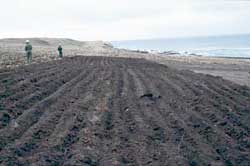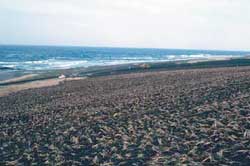Chapter 11: Transplanting and Sprigging (Advanced Techniques)
Of all revegetation techniques, the use of living plants or parts of living plants is the most labor intensive. However, there are times when the most appropriate revegetation method is planting transplants, sprigs or cuttings.
The most common and historically-used method of vegetative plantings in Alaska is the use of willow cuttings. Another more recent method of transplanting was developed and proven effective on the Aleutians under various Department of Defense contracts and studies. This technique relies on planting sprigs of beach wildrye (Elymus mollis, synonym Leymus mollis).
Revegetation techniques with vegetative material require a great deal of planning and should not be attempted without consulting experienced persons. Transplanting whole plants is not covered in this report.
Willow and Other Woody Cuttings
The use of willow cuttings has proven successful in all areas of Alaska where willow occurs naturally. Because timing is critical to both collection and planting, prior planning is an absolute necessity.
For detailed instructions, please refer to the Streambank Manual:
Moore, Nancy J., Jeanne Walter, Dean Hughes, Gay Muhlberg. 2005. Streambank Revegetation and Protection, A Guide for Alaska, Revised 2005. https://www.sf.adfg.state.ak.us/sarr/restoration/techniques/techniques.htm. Alaska Department of Fish and Game, Division of Sport Fish. 91pp.
Sprigging with beach wildrye, one of the most widely used transplant species, was initially developed and proven effective on Shemya Island. The species can be used anywhere in coastal and insular Alaska, however, dune areas adjacent to shorelines are ideal. Sand is the ideal medium for planting, but gravels and rocky soil will also support the species.


For directions, please refer to the Beach Wildrye Manual:
Wright, Stoney J. 1994. Beach Wildrye Planting Guide. State of Alaska, Division of Agriculture, Plant Materials Center. 29 pp.






